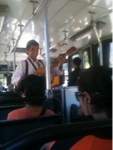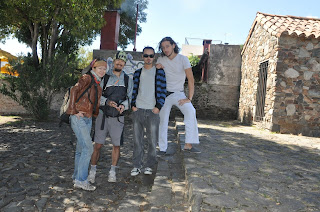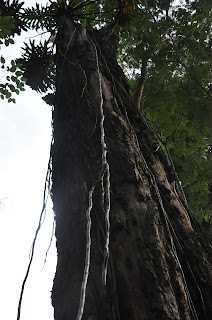
 The city claimed the origin of tango earlier than Buenos Aires. Compared to the prosperous tango scene and several milonga a night, Montevideo lagged behind and milonga were not frequent. Thanks to Mario, he
brought us to a small milonga in a wine house. We did not dance much because there were so few people, but we enjoyed the cozy atmosphere and the wine. It was our first time tasting Uruguay wine, typical wine of the new world
good for dining but not much on vintage tasting. The second milonga, after we made sweet and sour pork in Mario’s place (he liked Chinese culture and read literature of Lao-tze), was a Sunday milonga by Joven Tango, situated
in an old market (Mercado de la Abundacia). Our first impression of the tango there, because of the milonga, was that it was only danced by old people. We were the youngest couple there. Actually we just came at the wrong
time, there was another milonga the same night with younger tango population. Back to this one, we were not only the youngest, but also the best dancers there. There was even an old man in suit praising us that he treated us
free pizza and beer before we left (as we had to rush for the last bus back to Libertad). The organizer of the milonga, who was a woman, even gave us telephone number and asked if we could perform for them! We were flattered
by the invitation but we had other plan on the weekend, so we just took the number for future contact. The floor there was good, but the music there was very bad, the dj had no knowledge about tanda and mixed milonga and neuvo
in the same tanda. Even there were only two milonga coming together, the tanda had only these two songs. I had to stand a few second before figuring out what I should dance next. Therefore I did not dance much too.
The city claimed the origin of tango earlier than Buenos Aires. Compared to the prosperous tango scene and several milonga a night, Montevideo lagged behind and milonga were not frequent. Thanks to Mario, he
brought us to a small milonga in a wine house. We did not dance much because there were so few people, but we enjoyed the cozy atmosphere and the wine. It was our first time tasting Uruguay wine, typical wine of the new world
good for dining but not much on vintage tasting. The second milonga, after we made sweet and sour pork in Mario’s place (he liked Chinese culture and read literature of Lao-tze), was a Sunday milonga by Joven Tango, situated
in an old market (Mercado de la Abundacia). Our first impression of the tango there, because of the milonga, was that it was only danced by old people. We were the youngest couple there. Actually we just came at the wrong
time, there was another milonga the same night with younger tango population. Back to this one, we were not only the youngest, but also the best dancers there. There was even an old man in suit praising us that he treated us
free pizza and beer before we left (as we had to rush for the last bus back to Libertad). The organizer of the milonga, who was a woman, even gave us telephone number and asked if we could perform for them! We were flattered
by the invitation but we had other plan on the weekend, so we just took the number for future contact. The floor there was good, but the music there was very bad, the dj had no knowledge about tanda and mixed milonga and neuvo
in the same tanda. Even there were only two milonga coming together, the tanda had only these two songs. I had to stand a few second before figuring out what I should dance next. Therefore I did not dance much too.
On Tuesday in the same place there was a free practica by another organizer. It was raining hard on that day and before going we went to another tango place that we searched on internet but it turned out a
show-tango dinner placing costing several hundred dollar a person. This time most of the younger dancers come out. I would say the young community here is more welcoming than Buenos Aires. With my observation about good-looking
women in Uruguay, on average there were more than Buenos Aires, so were the good looking tanguaras. They even invited men for dance. Although the dj sucked again, at least I enjoyed more dancing on this Tuesday. Maria had
more handsome guys dancing with them, but most of them were not good leaders. I hope she enjoyed dancing with handsome guys.
 The last milonga we had in Montevideo was one Thursday in a pub on Jose E Rodo street next to the crossing on the main Bvar. Gral. Artigas. Good dj, good floor, beautiful dancers, free wifi, what else can we
ask ? We had a good time from 11pm (the BsAs typical start time) to 3am in the morning (still early in BsAs standard but there were not many dancers left at that time). The time schedule of tango of Montevideo matched a 9-5
life better than BsAs. Actually we can go to this Thursday milonga again before we left, but we enjoyed staying in the place of a new host Felipe (also we were short of cash and did not want to change more peso) so much that
we did not go.
The last milonga we had in Montevideo was one Thursday in a pub on Jose E Rodo street next to the crossing on the main Bvar. Gral. Artigas. Good dj, good floor, beautiful dancers, free wifi, what else can we
ask ? We had a good time from 11pm (the BsAs typical start time) to 3am in the morning (still early in BsAs standard but there were not many dancers left at that time). The time schedule of tango of Montevideo matched a 9-5
life better than BsAs. Actually we can go to this Thursday milonga again before we left, but we enjoyed staying in the place of a new host Felipe (also we were short of cash and did not want to change more peso) so much that
we did not go.
In all, the tango in Montevideo could still not be compared to Buenos Aires in terms of music and dance level. However, the more friendly community and common higher standard of outlook of the tangueras made
her also a good place for me.














































